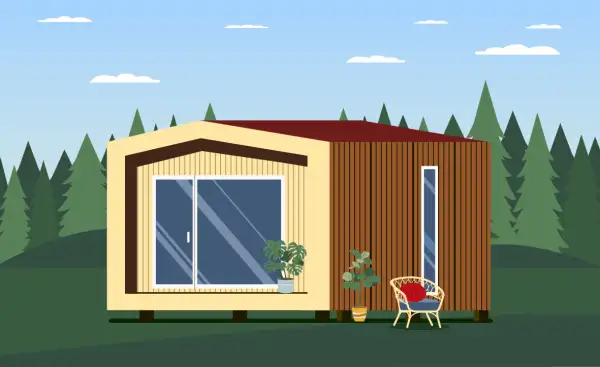The Big Challenges of Living in a Tiny Home

Few things have had a heyday as big as the tiny home. In the mid-2010s, these pint-sized houses started popping up everywhere; gracing magazines, commanding staggering social media followings and spawning at least five reality TV shows. (Several on the same four-letter network.)
A decade later, the novelty has worn off, but the hype lives on. In 2023, the global market for tiny homes — typically defined as units less than 400 square feet — was valued at $5.61 billion, according to the market research firm DataBridge. By 2031, the company predicts, that number will reach $7.38 billion.
In a market with stubbornly high home prices, the allure makes sense: Affordable, quick to build and requiring little furniture or decor, tiny homes seem like the perfect fit for many cash-strapped buyers.
But for some people who hopped aboard the "live tiny" movement in its early days, the reality has proved quite different. Shoddy workmanship led to mold growth. Heads were bonked and arms were whacked on too-low ceilings. Privacy was near impossible, and the lack of common creature comforts, like a proper kitchen, comfortable seating and storage space, made the experience lose its luster.
“It’s not ideal at all,” says Adam Junod, a creative director and graphic designer who’s been living in his 150-square-foot home with his now-wife, Emily and 60-pound black lab, Luna, off and on since 2016. The pair are welcoming a newborn baby in just a few weeks.
“I literally cannot put my hands above my head,” he says. “When we walk, the dishes rattle, and it’s off-kilter, so I have to push the shower water into the drain. The whole thing shakes when the air conditioner is on.”
To be clear, the minimalistic, live-small philosophy of the tiny home has its upsides. There’s less to clean and fewer belongings to keep up with, and they’re often portable, allowing you to live wherever your life takes you. For many — including Junod’s family — it also reduces living costs by thousands of dollars per month. But even for those who love the tiny home life, it comes with challenges that can’t be ignored.
Finding space
Many tiny homeowners buy their properties from specialty builders, who often build the homes off-site and then ship them directly. Others build their homes from scratch themselves. Either way, the cost is pretty low — especially compared to traditional single-family homes.
The exact total depends on the size, but most pay between $30,000 and $70,000 for a tiny home, according to home contracting platform Angi. (The current median home price, on the other hand, is over $412,000).
But buying a tiny home is only the first step. After that, buyers need to cross their first hurdle: Where to place the property.
In many cities, the legality of tiny homes is iffy — and subject to zoning codes and building regulations that vary from one zipcode to the next. Because of this, finding the right spot requires some creativity — and, often, a rural patch of land with little oversight.
Jenny Comperda, a park ranger who’s lived in a 280 square-foot tiny home since 2018, has moved several times due to her job, and each time, “the biggest challenge is finding a place to put it,” she says. In the past, she’s lived on a vineyard, in a friend’s yard and in an RV park. Today, she rents a spot on a lavender farm in Grass Valley, Calif.
When the Junods started their tiny home journey, they placed their home on a lot outside of Austin, Texas, along with several other tiny homes. Eventually, they bought a traditional house in Oregon and moved their tiny home to the backyard, renting out the main property to earn extra income.
And while the portability of many tiny homes is certainly a perk for those who regularly relocate, it presents yet another challenge — and a costly one, at that.
“Moving the house is quite a task and requires hiring a professional driver,” Comperda says. For her last move, Comperda paid a whopping $2,500 for driving services alone.
Finding privacy
Securing a physical space for the home is one item in a long list of obstacles many tiny home owners face. Another big challenge is the limited space these homes come with. While it’s an inherent — and expected — part of tiny home living, owners say it also has a pretty steep learning curve.
For one, there’s no privacy — at least for those who share the space with someone else. Junod says with two people in his home, plus backyard neighbors, carrying on private phone conversations is near impossible. And getting alone time — even in the bathroom? That’s a thing of the past. Put bluntly: “We poop in front of each other,” he says.
Pets and kids further complicate things. Jenny had to make room for her pet rabbit, Polly Moonstone Angelfeather, and with a baby on the way, the Junods are ditching their dinette table for a dog crate.
“She’ll have her own space as we welcome a new baby into the home,” Junod says.
For those who work from home, there are added struggles. Some people find ways to mount a computer screen to their wall or install a fold-down desk chair to save on space, while others work outside on a hand-built deck or under an awning.
Kellie Dyer and her husband — both of whom work remotely — opted to install a portable shed outside their 399-square-foot Yantis, Texas home. “We had to get creative,” she says.
Less items, more work
One of the perks of tiny home living is that you don’t need to buy tons of furniture or home decor. And while that can save you cash, it has its drawbacks, too.
Dyer’s home, for instance, didn’t have room for a kitchen table, making for a “depressing” dinner time. “We ended up eating on the couch for the first year,” she says.
It also requires a lot of upkeep. Though minimal storage space and few belongings mean the home is easy to clean, it also means cleaning almost constantly.
“On the one hand, I could vacuum and mop in record time,” Dyer says. “But on the other, any amount of clutter would very quickly become a tripping hazard or simply seem claustrophobic.”
Another potential hazard tiny homeowners often face? That’d be mold. It’s sometimes due to poor building tactics, a lack of airflow in the home or lackluster insulation, but the problem can get out of hand quickly — particularly in humid climates.
“Tiny homes are being built to lower standards than regular homes,” says Corinne Segura, a former tiny home dweller who suffered mold issues herself. Builders are also working with less space, she says, so they’ll often cut corners and leave out crucial features that could stave off mold — things like roof venting, rainscreens and even drywall.
Segura had her tiny home built in 2014, and mold started to develop quickly thereafter — on the ceiling, in the insulation, on the wheel wells and more. She tried to repair the property, but developed health problems due to the mold exposure.
“I ended up giving up on fixing it and sold it for a huge loss,” Segura says. “I paid more than $100,000 and sold it for $30,000.”
Segura’s experience inspired her to become a certified healthy home and moisture intrusion inspector. She also operates My Chemical-free House, a website dedicated to helping others build safer, healthier tiny houses.
When it’s worth the hassle
Despite the unique headaches that come with it, some tiny home residents say the lifestyle is worth it.
For Comperda, tiny living has allowed her to save up “a lot of money” over the years — almost enough for a down payment on a property she’s been eyeing, and though Dyer has since moved into a traditional home in Evansville, Indiana, she says she’d “definitely” live tiny again if given the opportunity.
The Junods have saved tons, too. They plan to put the money toward building a mixed-use sustainable community in the Pacific Northwest down the line — one with tiny rental properties, retreat space, recreation opportunities and more.
“We both know that what we're doing right now is sacrificing a little bit of comfort for our future to be better,” Junod says. “We have a larger vision.”
More from Money:
10 Cities Where Buying a Home Is Now Cheaper Than Renting
The Best Time to Buy a House Is Coming Up Soon
'Zombie' Mortgages Are Back With a Vengeance to Haunt Homeowners

